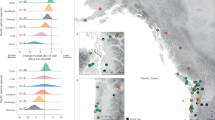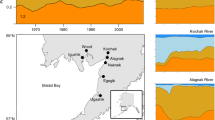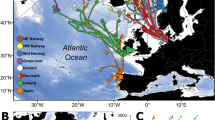Abstract
Historical catch records suggest that climatic variability has had basin-wide effects on the northern Pacific and its fish populations, such as salmon, sardines and anchovies1,2,3,4,5,6,7. However, these records are too short to define the nature and frequency of patterns. We reconstructed ∼2,200-year records of sockeye salmon abundance from sediment cores obtained from salmon nursery lakes on Kodiak island, Alaska. Large shifts in abundance, which far exceed the decadal-scale variability recorded during the past 300 years1,2,3,4,5,6,7,8, occurred over the past two millennia. A marked, multi-centennial decline in Alaskan sockeye salmon was apparent from ∼100?BC to AD 800, but salmon were consistently more abundant from AD?1200 to 1900. Over the past two millennia, the abundances of Pacific sardine and Northern anchovy off the California coast, and of Alaskan salmon, show several synchronous patterns of variability. But sardines and anchovies vary out of phase with Alaskan salmon over low frequency, which differs from the pattern detected in historical records5,6. The coherent patterns observed across large regions demonstrate the strong role of climatic forcing in regulating northeastern Pacific fish stocks.
This is a preview of subscription content, access via your institution
Access options
Subscribe to this journal
Receive 51 print issues and online access
$199.00 per year
only $3.90 per issue
Buy this article
- Purchase on Springer Link
- Instant access to full article PDF
Prices may be subject to local taxes which are calculated during checkout




Similar content being viewed by others
References
Beamish, R. J. & Bouillon, D. R. Pacific salmon production trends in relation to climate. Can. J. Fish Aquat. Sci. 50, 1002–1016 (1993).
Francis, R. C. & Hare, S. R. Decadal-scale regime shifts in the large marine ecosystem of the north-east Pacific: a case for historical science. Fish Oceanogr. 3, 279–291 (1994).
Mantua, N. J., Hare, S. R., Zhang, Y., Wallace, J. M. & Francis, R. C. A Pacific interdecadal climate oscillation with impacts on salmon production. Bull. Am. Meteorol. Soc. 78, 1069–1079 (1997).
Francis, R. C., Hare, S. R., Hollowed, A. B. & Wooster, W. S. Effects of interdecadal climate variability on the oceanic ecosystems of the NE Pacific. Fish Oceanogr. 7, 1–21 (1998).
Beamish, R. J. et al. The regime concept and natural trends in the production of Pacific salmon. Can. J. Fish Aquat. Sci. 57, 516–526 (1999).
Lluch-Belda, D. in Large Marine Ecosystems of the North Pacific Rim (eds Sherman, K. & Tang, Q.) 42–47 (Blackwell Science, Malden, Massachusetts, 1999).
Hare, S. R. & Mantua, N. J. Empirical evidence for North Pacific regime shifts in 1977 and 1989. Prog. Oceanogr. 47, 103–145 (2000).
Finney, B. P., Gregory-Eaves, I., Sweetman, J., Douglass, M. S. V. & Smol, J. P. Impacts of climatic change and fishing on Pacific salmon abundances over the past 300 years. Science 290, 795–799 (2000).
Welch, D. W., Ishida, Y. & Nagasawa, K. Thermal limits and ocean migrations of sockeye salmon (Oncorhyncus nerka): long-term consequences of global warming. Can. J. Fish Aquat. Sci. 55, 937–948 (1998).
Burgner, R. L. in Pacific Salmon Life Histories (eds Groot, C. & Margolis, L.) 3–117 (UBC Press, Vancouver, 1991).
Gilpin, L. M. Holocene Paleoseismicity and Coastal Tectonics of the Kodiak Islands, Alaska. PhD thesis, Univ. California Santa Cruz (1995).
Burger, C. V., Scribner, K. T., Swanton, C. O. & Campton, D. E. Genetic contribution of three introduced life history forms of sockeye salmon to colonization of Frazer Lake, Alaska. Can. J. Fish Aquat. Sci. 57, 2096–2111 (2000).
Mills, R. O. Radiocarbon calibration of archaeological dates from the central Gulf of Alaska. Arctic Anthropol. 31, 126–149 (1994).
Knect, R. The Late Prehistory of the Alutiiq People: Culture Change on the Kodiak Archipelago from 1200–1750 AD. PhD thesis, Bryn Mawr College, Pennsylvania (1995).
Jackson, J. B. C. et al. Historical overfishing and the recent collapse of coastal ecosystems. Science 293, 629–638 (2001).
Venrick, E. L., McGowan, J. A., Cayan, D. R. & Hayward, T. L. Climate and chlorophyll a: long-term trends in the central north Pacific Ocean. Science 238, 70–72 (1987).
Brodeur, R. D. & Ware, D. M. Long-term variability in zooplankton biomass in the subarctic Pacific Ocean. Fish Oceanogr. 1, 32–38 (1992).
Pisias, N. G. Paleoceanography of the Santa Barbara Basin during the last 8000 years. Quat. Res. 10, 366–384 (1978).
Kennett, J. P. & Ingram, B. L. A 20,000-year record of ocean circulation and climate change from the Santa Barbara basin. Nature 277, 510–513 (1995).
Calkin, P. E., Wiles, G. C. & Barclay, D. J. Holocene coastal glaciation of Alaska. Quat. Sci. Rev. 20, 449–461 (2001).
Luckman, B. H., Briffa, K. R., Jones, P. D. & Schweingruber, F. H. Tree-ring based reconstructions of summer temperatures at the Columbia Icefield, Alberta, Canada, AD 1073–1983. Holocene 7, 375–389 (1997).
Bennett, J. Paleoclimatic Investigations from a Closed-basin Lake in Southern Interior British Columbia. MSc thesis, Queen's Univ. Ontario (1999).
Pienitz, R., Smol, J. P., Last, W. M., Leavitt, P. R. & Cumming, B. F. Multi-proxy Holocene palaeoclimatic record from a saline lake in the Canadian subarctic. Holocene 10, 673–686 (2000).
Gargett, A. E. The optimal stability ‘window’: a mechanism underlying decadal fluctuations in North Pacific salmon stocks? Fish Oceanogr. 6, 109–177 (1997).
Baumgartner, T. R., Soutar, A. & Ferreira-Bartrina, V. Reconstruction of the history of Pacific sardine and northern anchovy populations over the last two millennia from sediments of the Santa Barbara Basin, California. CalCOFI Rep. 33, 24–40 (1992).
Juillet-Leclerc, A. & Schrader, H. Variations of upwelling intensity recorded in varved sediment from the Gulf of California during the past 3000 years. Nature 329, 146–149 (1987).
Tunicliffe, V., O'Connell, J. M. & McQuoid, M. R. A Holocene record of marine fish remains from the Northeastern Pacific. Mar. Geol. 174, 197–210 (2001).
Wilson, S. E., Cumming, B. & Smol, J. P. Assessing the reliability of salinity inference models from diatom assemblages: an examination of a 219-lake data set from western North America. Can. J. Fish Aquat. Sci. 53, 1580–1592 (1996).
Ennis, G. L., Northcote, T. G. & Stockner, J. G. Recent trophic changes in Kootenay Lake, British Columbia, as recorded by fossil diatoms. Can. J. Bot. 61, 1983–1992 (1983).
Clark, D. W. Kodiak Island: the later cultures. Arctic Anthropol. 35, 172–186 (1988).
Acknowledgements
We thank D. Barto, T. Chatto, R. Hander, S. Honnold, S. Schrof, N. Sagalkin and J. Sweetman for assistance in the field, and T. Brown, N. Haubenstock, A. Hirons, T. Howe, A. Krumhardt and M. Luoma for laboratory assistance. We are also grateful to J. Glew for drafting our map. B. Cumming, J. Dower, T. Johnston, D. Mann, and members of PEARL provided comments on the manuscript. This work was funded in the USA by the US Global Ocean Ecosystems Dynamics (GLOBEC) programme jointly funded by the National Science Foundation and the National Oceanic and Atmospheric Administration (NOAA), the Alaska Sea Grant College programme and the NOAA-Auke Bay Lab Ocean Carrying Capacity programme. In Canada, this research was supported by the Natural Sciences and Engineering Research Council of Canada (NSERC), the Ontario Graduate Scholarship (OGS) programme and the Northern Studies Training Program (NSTP).
Author information
Authors and Affiliations
Corresponding author
Ethics declarations
Competing interests
The authors declare that they have no competing financial interests
Rights and permissions
About this article
Cite this article
Finney, B., Gregory-Eaves, I., Douglas, M. et al. Fisheries productivity in the northeastern Pacific Ocean over the past 2,200 years. Nature 416, 729–733 (2002). https://doi.org/10.1038/416729a
Received:
Accepted:
Issue Date:
DOI: https://doi.org/10.1038/416729a
This article is cited by
-
Existing evidence on the impact of changes in marine ecosystem structure and functioning on ecosystem service delivery: a systematic map
Environmental Evidence (2023)
-
Learning from the past: opportunities for advancing ecological research and practice using palaeoecological data
Oecologia (2022)
-
Assessing past ecological tolerance of Pacific salmon (Oncorhynchus spp.) and saffron cod (Eleginus gracilis) in northwest Alaska using vertebra width and length reconstructions
Archaeological and Anthropological Sciences (2021)
-
Sedimentary DNA tracks decadal-centennial changes in fish abundance
Communications Biology (2020)
-
The history of seabird colonies and the North Water ecosystem: Contributions from palaeoecological and archaeological evidence
Ambio (2018)
Comments
By submitting a comment you agree to abide by our Terms and Community Guidelines. If you find something abusive or that does not comply with our terms or guidelines please flag it as inappropriate.



